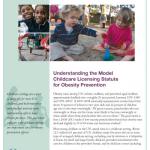Model Child Care Licensing Statute for Obesity Prevention
Sample standards for physical activity, nutrition, & screen time
Obesity rates among American infants, toddlers, and young children have risen along with rates among school-age children.
Over the past 4 decades, obesity rates among preschool children ages 2 to 5 have nearly quintupled, from 4 to 19 percent. A new national study also shows that over 18 percent of 4-year-olds are obese.
At the same time, the number of young children receiving care in childcare settings has increased. At least 60 percent of infants and children up to age 5 currently spend an average of 29 hours each week in some form of child care setting. Child care arrangements in the United States include care at home by relatives or a babysitter, by family child care providers (non-relative child care providers who care for two or more children in the provider’s home), and by child care centers (including nursery schools, preschools, and Head Start programs).
To date, government efforts to address the childhood obesity crisis have focused primarily on school-age children. Many states have adopted laws restricting the availability of low-nutrition, energy-dense foods in schools and mandating physical activity in schools. Yet few states have addressed regulating physical activity, nutrition and screen time, comprehensively for young children supervised in child care settings. These sample standards are provided as a guide and are not offered or intended as legal advice. Readers should seek the advice of an attorney when confronted with legal issues, and attorneys should perform an independent evaluation of the issues raised.
Be sure to check out the companion factsheet, Understanding the Model Child Care Licensing Statute for Obesity Prevention, that presents a quick look at what a community can do to promote health in its youngest members. As a companion piece, this fact sheet also offers a snapshot of the options detailed in this Model Statute.




